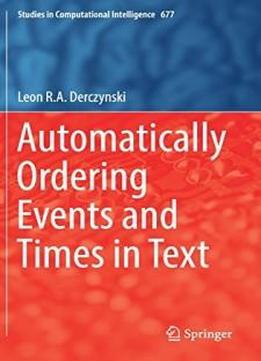
Automatically Ordering Events And Times In Text (studies In Computational Intelligence)
by Leon R.A. Derczynski /
2016 / English / PDF
7.1 MB Download
The book offers a detailed guide to temporal ordering, exploring
open problems in the field and providing solutions and extensive
analysis. It addresses the challenge of automatically ordering
events and times in text. Aided by TimeML, it also describes and
presents concepts relating to time in easy-to-compute terms.
Working out the order that events and times happen has proven
difficult for computers, since the language used to discuss time
can be vague and complex. Mapping out these concepts for a
computational system, which does not have its own inherent idea
of time, is, unsurprisingly, tough. Solving this problem enables
powerful systems that can plan, reason about events, and
construct stories of their own accord, as well as understand the
complex narratives that humans express and comprehend so
naturally.
The book offers a detailed guide to temporal ordering, exploring
open problems in the field and providing solutions and extensive
analysis. It addresses the challenge of automatically ordering
events and times in text. Aided by TimeML, it also describes and
presents concepts relating to time in easy-to-compute terms.
Working out the order that events and times happen has proven
difficult for computers, since the language used to discuss time
can be vague and complex. Mapping out these concepts for a
computational system, which does not have its own inherent idea
of time, is, unsurprisingly, tough. Solving this problem enables
powerful systems that can plan, reason about events, and
construct stories of their own accord, as well as understand the
complex narratives that humans express and comprehend so
naturally.
This book presents a theory and data-driven analysis of temporal
ordering, leading to the identification of exactly what is
difficult about the task. It then proposes and evaluates
machine-learning solutions for the major difficulties.
This book presents a theory and data-driven analysis of temporal
ordering, leading to the identification of exactly what is
difficult about the task. It then proposes and evaluates
machine-learning solutions for the major difficulties.
It is a valuable resource for those working in machine learning
for natural language processing as well as anyone studying time
in language, or involved in annotating the structure of time in
documents.
It is a valuable resource for those working in machine learning
for natural language processing as well as anyone studying time
in language, or involved in annotating the structure of time in
documents.











